
Originally published in The Clarinet 52/3 (June 2025).
Copies of The Clarinet are available for ICA members.
Book and Music Reviews:
June 2025
BOOKS
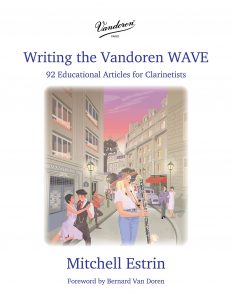
Mitchell Estrin. Writing the Vandoren WAVE: 92 Educational Articles for Clarinetists. Produced by DANSR, Inc. CAMco Music Publishing, LLC. 2024. 146 pages. $29. www.ClarinetAllMusic.com.
This publication is a collection of articles published in the Vandoren WAVE newsletter written by Mitchell Estrin, professor of clarinet at the University of Florida and the 20th president of the International Clarinet Association. This treasure trove is a culmination of his long-distinguished experience as a pedagogue and performer. Bernard Van Doren writes in the foreword to the book that Estrin has been a member of the Vandoren family for over 40 years and contributed greatly as an education and product consultant. The Vandoren WAVE was established in 2012. The articles are organized into eight chapters by the following topics:
- Foundation
- For the Student
- Teaching
- Repertoire
- Top 10 Lists
- Equipment
- Notable People and Musical Genres
- Clarinet Trivia Quizzes.
This book is hard to put down, as each article offers incredible tips, suggestions, and information about fundamentals, teaching, repertoire and so much more. The reader can’t wait to turn the page to see what great nuggets of information are in the next article.
Chapter 1, “Foundation,” includes 15 articles discussing fundamental elements of playing from breathing to dynamics, how to develop good finger technique, how to learn new music, and fantastic tips on organizing and executing practice time. These topics are concise, clear, and informative for use in the teaching studio and clarinet study. This chapter also includes tips for improving your E-flat clarinet playing.
Chapter 2, “For the Student,” is a collection of articles to guide high school and college-level students. Estrin begins this chapter with a discussion of collegiate audition preparation. He covers all the components of the process, from early planning to practicing the audition. The next article focuses on recital program planning, including how to build a program around a “centerpiece” work. Estrin offers more unique topics including ways to use your smartphone in the practice room and how to recover after an unsuccessful audition. The final article in this chapter discusses the importance of hearing protection and the decibel levels different instruments create. While the title of this chapter is directed at students, any professional player can benefit from the advice in these articles.
Chapter 3, “Teaching,” offers college teachers articles about performance anxiety, double lip embouchure, vibrato, and clarinet choir. Estrin’s points about performance anxiety help students understand that it is normal and there are pathways to navigating and reducing anxiety onstage. He also discusses the double-lip embouchure and how, while it is not as prevalent today, it can be a helpful tool in our teaching.
Chapter 4, “Repertoire,” includes in-depth information about standard well-known works and lesser-known masterpieces. Each topic includes historical data, practice and performance tips, and information to aid in the study of these composers or works. There is a comprehensive list of 20th-century English clarinet concerti and a discussion of the British clarinet school. Some of these concertos will be familiar, but most are not regularly programmed and worth further exploration. Additionally, Estrin offers a list of his favorite lesser-known masterpieces. These works would be appropriate for performers of all levels and should be considered alongside our standard repertoire.
Chapter 5, “Top 10 Lists,” offer 22 lists of tips for students, players and teachers. This could provide an engaging activity for the collegiate studio: teachers can utilize these lists as a weekly topic, then ask students to create their own top 10 lists on the same or different topics. Each list is jam-packed with great ideas and suggestions, particularly music books to consider and repertoire to explore.
Chapter 6, “Equipment,” includes information about mouthpieces, mouthpiece care, reeds, and ligatures, including information specific to Vandoren equipment. The article discussing winterizing your equipment is incredibly helpful for anyone living in a winter climate, particularly on the topic of how to protect your wood clarinet and how to manage reeds during the winter months. Estrin presents an article about the mpingo wood, best known as grenadilla, the wood most commonly used to make clarinets.
Chapter 7, “Notable People and Musical Genres,” delves into an array of topics about great players, pedagogues, composers, and styles such as big band, klezmer, Turkish music, and more. The first article focuses on the life of Benny Goodman including a listing of all the incredible pieces he commissioned. English clarinetist Reginald Kell is the focus of the next article which highlights Kell’s life as a performer, recording artist, and pedagogue. This chapter also highlights the lives of 20th-century Juilliard clarinetists Joe Allard, Stanley Drucker, Leon Russianoff, and David Weber, all legendary pedagogues and players. The music of Scott McAllister is given a special spotlight including four of his major works for clarinet. The final articles in this chapter center around the clarinet in the recording studio, including work for commercials and soundtracks.
Chapter 8, “Clarinet Trivia Quizzes,” includes questions to test your knowledge. See how much you know and challenge yourself and your students to discover more! Can your students come up with their own trivia quizzes?
Mitch Estrin has hit a home run with this collection of articles. These pieces are concise, engaging and exciting to peruse. Thank you to Vandoren for creating the WAVE newsletter to share these incredible pearls. All clarinetists should include this resource in your 2025 reading list whether you are a professional performer, educator, enthusiast, or student.
– Juliane Kirk Doyle
MUSIC

Wolfgang Amadeus Mozart. Ah, vous dirai-je Maman, KV 265, theme and variations for clarinet and piano, arranged by Frédéric Cellier. Stradivarius Editions, 2010. €9.99.
The famous theme “Ah, vous dirai-je Maman” was a popular French song of the mid-18th century, now known to English speakers as “Twinkle, Twinkle, Little Star” or “The ABC Song.” The text of this song originated from another French song, “La Confidence naive.” This simple, 12-bar theme has been so popular that it has been used for many different songs, translated into many different languages, and used for carillons and toys. It also interested the genius of Mozart. When he visited France in 1778, he heard this theme and decided to compose 12 beautiful variations in C major for piano solo (KV 265). So far, this theme has been used for endless arrangements for various instrumental combinations, including this very good one for clarinet and piano by Frédéric Cellier. Cellier is the head publisher of Stradivarius Editions and the arranger of hundreds of compositions of music from all periods, for brass, strings, woodwinds (also chalumeau!), harp, mandolin, saxophone, and voice. This sounds quite amazing! On the Stradivarius website, there are dozens and dozens of arrangements of compositions from Mozart, Beethoven, Haydn, and many other composers. We can also find the Heinrich Baermann Clarinet Quintet op. 23 in its original form. Stradivarius Editions can also provide PDF versions of these arrangements. The beautiful website of this publishing house also offers some intriguing sections including photographs, quotes, paintings, fingering charts, engravings, drawings, caricatures, and documentation regarding all instrumental categories. A real treasure of information! Bravo, Mr. Cellier, for your incredible job!
– Luigi Magistrelli
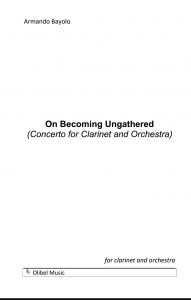
Armando Bayolo. On Becoming Ungathered (Concerto for Clarinet and Orchestra). Olibel Music, 2024. https://armandobayolo.com/.
Composer Armando Bayolo (b. 1973) confronts cosmic forces in his new clarinet concerto, On Becoming Ungathered (2024). His existential musical material, inspired by the concept of perpetually recycled subatomic “stardust,” depicts human form and consciousness in its transitory relationship to the eternal nature of matter and energy. Bayolo’s treatment of such sublime subject matter yields a massive and powerful work, a musical universe seemingly aware of its ever-vacillating emotions and structures. The concerto spans roughly 25 minutes and requires a large orchestra (3333-4331 tymp+perc, hp, pf, str). Bayolo creates two distinctive movements that he bridges with a clarinet cadenza. The first of these movements contains four “elemental fanfares” following an atmospheric opening: a woodwind fanfare represents water, a colorful percussion fanfare represents earth, a brass fanfare represents fire, and a combination of sonorities and timbres (harmonics, air noise, etc.) in the strings/woodwinds/brass represents wind. The ephemeral clarinet solo weaves energetically between the fanfares, with Bayolo suggesting its role as “the universe itself contemplating its existence, perhaps.” It recalls the distinctive “ignis fatuus” character from the “Cadenzas” movement of Corigliano’s famous clarinet concerto. Bayolo’s cadenza begins furiously, emerging from the disintegration of the previous movement’s materials, then “gives way tomeditation and melancholy,” its long final resonance trill becoming wind noise as it leads into the slower and more contemplative second movement. Bayolo uses the ideas of a “nocturne” and an “aria” to structure this movement; he forges each from earlier material, “transformed like matter within a star.” The clarinet solo presents considerable technical challenges, including endurance, range, articulation, and dexterity. Some passages will require multiple articulation from most (if not all) performers. Eric Schultz, the commissioner and dedicatee of this work, will give the premiere in November of 2025 on a tour that includes performances with the St. Louis Symphony, the Orquesta Sinfónica de Puerto Rico, and the New England Philharmonic.
– Matthew Nelson
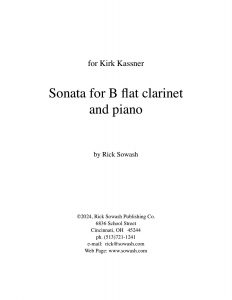
Rick Sowash. Sonata in B–flat (Kassner Sonata) for clarinet and piano; Rondo Pastorale for BÌ clarinet and piano: Homage to Gerald Finzi. Rick Sowash Publishing Company, 2024. Free.
Rick Sowash (b. 1950) is a prolific composer of music for clarinet. His works have been performed by Elsa Ludewig-Verdehr and the St. Petersburg Symphony Orchestra. Sowash’s music is alive with a similar spirit to the music of Ives or Copland; textures are often stark, but not cold, and the melodic language is accessible. Sowash’s two works, the Kassner Sonata and Rondo Pastorale, are great examples of his excellent clarinet writing.
The Kassner Sonata is composed in five movements: “Wintry Dawn,” “Scherzo,” “Largo,” “Fugue,” and “Rondo Finale.” “Wintry Dawn” opens with an unaccompanied clarinet melody, much like a fanfare on a brass instrument. As the clarinet melody becomes more and more complex, the piano enters. The clarinet and piano eventually become duet partners, but with the clarinet line consistently leading. The “Scherzo” opens as a call and response between the clarinet and piano and continues this way until rehearsal B, where the dotted-eighth melodic idea from the opening is explored more fully, and the piano takes on a supporting role. This continues until rehearsal D where the clarinet and piano resume the call and response, but now in a new tonal area. The range and technique of this movement are also very accessible. In the “Largo” movement the piano takes on a much more active role, with a clarinet melody reminiscent of the third movement of the Saint-Saëns Sonata in its straightforward intensity and texture. The “Fugue” movement is by far the most technically challenging movement, but it is still very accessible regarding range, tempo, and rhythmic complexity in the clarinet part, and appears to lay very well on the instrument. The final movement, “Rondo Finale,” has the clarinet and piano parts again more equally matched in terms of sharing the melodic responsibilities. Written in compound duple meter, and with the indication “a pirate song” in measure 23, this is a movement full of quirks and fun, with a limited tessitura that makes it an option for those who still may be unsure of venturing into the more extreme areas of the altissimo range. Overall, this piece would be a great addition to any performer or teacher’s library because of its variety of styles, accessibility, and charm. Though the work runs around 20 minutes in total, the movements could easily stand on their own for performance or be paired to make them fit the time limits of recitals or jury examinations.
The Rondo Pastorale is a standalone work in one movement. The piano begins alone before the clarinet enters with a lush low register melody. As it develops, the piano becomes more active, and we can clearly hear the influence of Finzi in the composer’s writing—the work is subtitled as an homage to Gerald Finzi. Near measure 60, the meter modulates from simple to compound, with the original melody now transformed, an excellent opportunity for expression for the performer and learning for a student musician. As the harmonies swirl, by measure 127 we find ourselves back in simple meter before we are returned to the piano melody from the beginning, now in the clarinet line, at measure 147. The soaring lines, lush harmony, and surprising harmonic movement make this piece an excellent selection shorter for a recital (it’s around 7 minutes total), and a great example of melodic development for a student musician to study. The range is highly accessible even to an intermediate-level player. There are moments of rhythmic complexity, but nothing exceeding the level of a college undergraduate student.
Sowash’s two works for clarinet are a worthy investment for both developing and professional performers to explore the more pastoral and tonal area of contemporary music, and they are highly recommended.
– Vanessa Davis
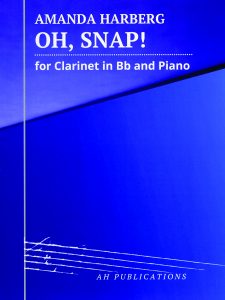
Amanda Harberg. Oh, Snap! for clarinet and piano. AH Publishers, 2024. PDF $24.99. Print $38.00.
Amanda Harberg (b. 1973) is one of today’s leading composers. Her writing combines classical Western tradition with contemporary influences to create a distinctive style which “conveys a thoroughly original sense of happiness in music” (Cleveland Classical). She has received commissions from the Philadelphia Orchestra Association, the New World Symphony, the Grand Rapids Symphony, the Juilliard School, and the Dorian Wind Quintet, among others. Her compositions have also been performed in such notable venues as Carnegie Hall, Lincoln Center, and the Philadelphia Chamber Music Society. Among the awards she has received are a Fulbright Fellowship, the Juilliard School’s Peter Mennin prize, and a MacDowell Colony summer residency. Also a concert pianist, she has performed with principals of numerous major orchestras including Philadelphia, New York, Baltimore and Los Angeles. She is currently in her sixth year of teaching composition at Rutgers University Mason Gross School of the Arts, and in the summers, she is on the composition faculty at the Interlochen Arts Camp.
Oh, Snap! for B-flat clarinet and piano, composed in 2024, was written for and dedicated to Eric Schultz, assistant professor of clarinet at Coastal Carolina University in Conway, South Carolina. It was commissioned by Coastal Carolina’s Edwards College and the Center for Inclusive Excellence, of which Schultz is the director. The composition was premiered by Schultz and Harberg herself on the piano on March 15, 2024 at Coastal Carolina University, and the premiere is viewable on YouTube.
Harberg has written numerous other compositions for clarinet, including a Sonata for clarinet and piano (2015), Hall of Ghosts for solo clarinet (2020); a concerto with orchestra or wind ensemble (2022); a woodwind quintet (2017), and numerous other small and large chamber works composed between 2009 and 2022. Oh, Snap! is a short, humorous piece lasting approximately 4 minutes. Its brevity and lightness contrast with some of her lengthier and more serious compositions. The piece is written in a jazz style with numerous seventh and ninth chords. It is marked “Flamboyant” and gives a metronome marking of 120 to the quarter note. In keeping with its title, Oh, Snap! starts with tongue-in-cheek snapping alone by the clarinetist on beats two and four of 4/4 time. The piano then enters and the clarinet follows. Additional snapping occurs later in the piece. The clarinet and piano mostly play together except for a short cadenza for the clarinet alone toward the end. Syncopated rhythms pervade, and the music is tuneful in character. Though rhythmically challenging, it adheres to its 4/4 time, save for a few meter changes. Most of the piece involves fast playing by both clarinetist and pianist, but a lyrical section marked “nostalgically and freely” precedes the cadenza. Oh, Snap! ends with a trill in the clarinet that dissipates into nothingness.
The clarinet line of Oh, Snap! is extremely soloistic, but an adept pianist is still required. The piece is not extremely demanding on either musician, save for many running 16th and 32nd notes in the clarinet. It does go up to an extreme high C in the clarinet; but the composer allows for an optional version an octave lower if desired. The only extended techniques required are pitch bends and glissandos. However, at the premiere recording, Schultz added some growling, flutter tonguing, and multiple articulation. The premiere recording is outstanding, and it is fantastic to have the dedicatee and composer together in this online resource.
In conclusion, Harberg has written yet another wonderful piece for the clarinet. Oh, Snap! is a concise, accessible, and light-hearted composition. What a charming gift to the clarinet world and to the music repertoire in general!
– Rebecca Rischin
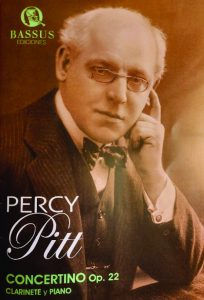
Percy Pitt. Concertino, op. 22 for clarinet and orchestra, edited by Pedro Rubio and Ana Benavides. Bassus Ediciones, 2024. €15.
Percival George (Percy) Pitt (1869-1932) was an English organist, pianist, conductor, and composer. He studied in Germany with Carl Reinecke and Jaromir Rheinberger and then returned to England, working for the Queen’s Hall Orchestra. From 1896 he was the pianist, organist, and celesta player of that orchestra. Later he became assistant director and musical advisor of the Royal Opera House in Covent Garden and in 1915 was appointed director of the Beecham Opera Company. Later he had more commitments with other important British orchestras. As a composer he wrote several stage pieces and some solo compositions intended for great virtuoso players, such as this Concertino dedicated to the Spanish virtuoso Manuel Gomez, who settled in London with the Spanish community, and the Ballade for violin and orchestra dedicated to Eugene Ysaye (1858-1931). [Learn more about the Percy Pitt Concertino in the feature article by Pedro Rubio in The Clarinet 52/3 (June 2025). Ed.]
This curious clarinet composition is well-tailored for the virtuosity of Gomez who premiered it for the Promenade Concerts on October 9, 1887, performing it with the Queen’s Hall Orchestra conducted by H. J. Wood. This piece has various tempo indications but no separate movements. One particular feature of this Concertino (about 20 minutes long, resembling a Romantic concerto!) is that Pitt wanted, at the suggestion of Gomez, to take some themes from at least two clarinet compositions (Concerto no. 2 and Etude/Capriccio no. 19) of the great Italian clarinet virtuoso Ernesto Cavallini, well known in Europe in that period. Just before the final flashy technical part is a very long and demanding cadenza, conceived with a violin-like writing style. An easier and shorter version of this cadenza is also provided by the composer. As Pedro Rubio states, this piece has that curious “English” mixture of German Romantic grandiloquence and some moments of lightness from the operetta, like in the style of the better-known Arthur Sullivan and others. From the historic point of view, the Concertino is important since we don’t have anything similar written in this period. Unfortunately, the orchestral version is lost.
Pedro Rubio is a well-known Spanish clarinetist, researcher and publisher. In the catalog of his publishing house Bassus Ediciones, he has already produced a long list of very interesting forgotten clarinet pieces written by Spanish composers. This modern edition of this curious composition edited by Rubio and Ana Benavides is very well prepared, with all accurate details in terms of an elegant and beautiful cover, exhaustive preface in two languages, and meticulous philological explanations, like a real urtext edition. Highly recommended!
– Luigi Magistrelli
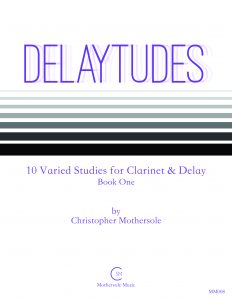
Christopher Mothersole. Delaytudes: 10 Varied Studies for Clarinet and Delay, Book One. Mothersole Music, 2024. PDF $25. Recorded performances available on YouTube.
By now, it’s safe to say that most of the ICA membership knows the name Christopher Mothersole. His ClarinetFest® performances for the past few years have been standing-room only events. He’s been a featured cover artist for The Clarinet. And all with good reason. His incorporation of electronic pedal effects with performance on the clarinet has opened up a new set of possibilities that borrow from the visceral and energetic sound world of electric guitar. Given the popularity of his performances, it’s not surprising that Mothersole would get a good amount of interest from other clarinetists who want to make these kinds of sounds, too. And if someone asks, “How do I do that?” what better response than a set of studies giving methodical and clear answers?
The first section of Delaytudes (such a great title, by the way) explains how to set up the equipment to get started. This Setup Guide describes the barrel with acoustic pickup to get sound from the clarinet, the effects processor (a traditional foot pedal or computer software), and amplification. By giving specific product recommendations for each of these, Mothersole makes it easy for a player to find the necessary equipment and get going. Given the broad array of available electronic products, knowing which ones will work well with the clarinet can cut out a lot of setup time. Mothersole includes a link to his website that clearly shows his effects setup in a user-friendly layout that presumably will also be current with what devices he currently uses, making updates to hardware readily available as technology changes in the future.
In notating the Delaytudes, Mothersole has devised a clear system that shows both how to set up the delay effects and what to expect while hearing them play back. This clarity is valuable for a beginner to the digital effects world who might benefit from confirmation that they’re doing the right thing at the right time. In the preface, Mothersole notes that the process of playing with a delayed version of one’s own sound has the extra bonus of helping work on issues of intonation and rhythmic stability, qualities that benefit a player even outside of the digital performance realm. Each of the Delaytudes focuses on a specific aspect of working with the delay. The first one includes judiciously positioned rests to allow the clarinetist to hear where the delayed notes lie. It requires precise rhythm, which sets up the expectation that the other Delaytudes require. The tempo is quick with changing meters, demonstrating from the beginning that this is a book that presupposes a high level of capability on the clarinet. The level of mastery required feels like that of a strong college-level performer. Subsequent Delaytudes build on the initial skillset with elements like nearly constant 16th notes (no. 2), fast and precise single note slapback delays (no. 3), and a more environmental atmosphere of building timbres (no. 4). The Delaytudes are progressive, requiring higher degrees of rhythmic precision, metric stability, and musical sensitivity with each new etude. The tenth and final Delaytude is almost entirely syncopated, requiring a sophisticated blend of rhythmic accuracy with lyrical connection to make the piece work musically. It is, in a sense, a final exam that showcases the techniques that the clarinetist will have developed by working through the other nine pieces. The effect is a virtuosic blend of the elements that make playing with delay effective and compelling. Listening to a performance of Delaytude no. 10 could be the best inspiration to spend time working through the pieces that step up into it. The last part of the title, “Book One,” seems to be a subtle clue that there are more books like this one forthcoming, perhaps focusing on other aspects of effects-augmented clarinet playing. Let’s all hope so, since this first one is so well-constructed and effective. No pun intended.
– Gregory Oakes
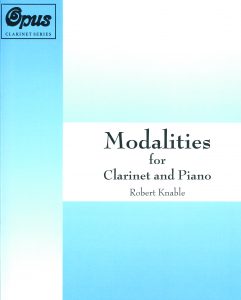
Robert Knable. Modalities for clarinet and piano. Opus Music Publishers, 2024. $14.95.
Knable’s Modalities begins with a mood of anticipation as eighth notes in 9/8 time rise and fall gently and softly in Dorian mode, with another line later hinting at the Locrian mode. It moves into an altissimo, fortissimo section, with a bit of hemiola before it relaxes into a 9/4 section with a new melody in the piano. The metric modulation and tonal harmonic language under the modal melodies make the piece easy to listen to and pleasing to play. Often the harmonies in the piano are quartal and quintal below the clarinet, with frequent suggestions of modes before the clarinet line moves quickly away to a new mode or tonal area. A new lilting section is heard in the clarinet, with embellishments of 16ths. This builds tension before a lively and energetic section arrives in 9/8 with dotted eighths followed by 16th notes. A section in 9/8 returns before the first section material comes back to close the piece out, but this time with more dramatic flair, 16th-note runs, and louder dynamics. The work is idiomatic, as Knable himself is a clarinetist. The passages in the altissimo registers are beautiful and manageable at the same time. It is about 7 minutes in duration. The clarinet part is three pages, has its own cover, and is printed clearly with thoughtful page turns.
– Katrina Phillips
Comments are closed.